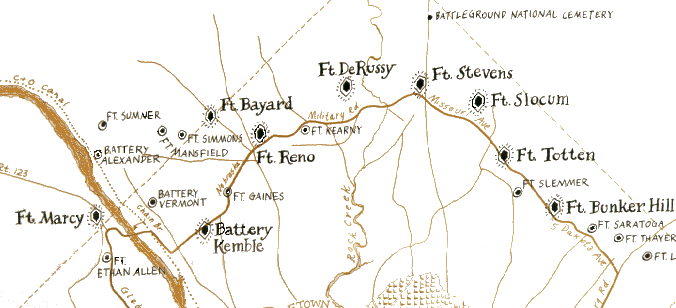During the 1970s the University of Texas at Austin engaged in a wall-building orgy, driven by legislated restrictions on how the school's Permanent Fund could be spent. High oil prices brought in a flood of cash. Bricks and mortar were authorized expenditures; scholarships and faculty salaries weren't. This caused much merriment among students at the time (I was one) and soon led to a change in the endowment rules, much for the better.
A more serious frenzy of wall-making occurred in the Washington DC area starting in late 1861. As the Civil War began the Union's capital stood naked, vulnerable to Confederate attack. To protect the Federal city a ring of fortifications was built. This major construction project is described in the US National Park Service's web pages on "The Civil War Defenses of Washington": [1], [2], etc. Here's a sketch (thanks again to the NPS):

Even though their main purpose was deterrence some of these forts did in fact witness battle. Decayed remains of the structures can still be seen in a few places today. (Captain Toby Shandy, Tristram's uncle in Lawrence Sterne's Tristram Shandy, would be fascinated!)
Fast forward 140 years: fresh fences, tall and spikey, are springing up around various Federal establishments in Washington, DC and nearby. With these palisades are concrete walls, tank traps, pop-up barriers, and guard posts. Near my home and jogging routes I've noted major new defenses around the National Institutes of Health and the Walter Reed Annex (Army Medical Center) grounds.
Foolish waste of resources, or prudent investment to prevent terrorist disaster? Parallel to earlier building sprees, or new situation entirely? Hard to say ...
TopicSociety - TopicPersonalHistory - 2003-11-28
(correlates: TristramShandy, NewsworthyMathematics, AntiQuaintances, ...)